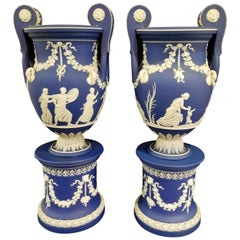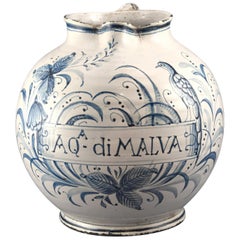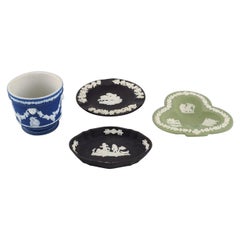European Ceramics
72
1
1
to
21
31
30
74
74
74
2,454
1,091
885
627
294
274
187
148
74
47
46
37
23
16
8
2
2
24
28
20
2
8
5
2
1
1
2
68
16
12
8
4
74
34
33
10
10
18
2
2
2
2
Style: Neoclassical
Place of Origin: European
Pair of Deep Red Glaze and 24ct Gold Leaves Majolica Vases, Italy, 21st Century
Located in London, GB
Pair of vases by Antonietta Mazzotti Emaldi, 2018, Glazed earthenware (majolica) and 24ct gold, entirely handmade, unique pieces.
Antonietta Mazzotti (Faenza, Italy 1950) attended the Istituto d’Arte per la Ceramica in Faenza and opened her first workshop in her hometown taking part in group and solo exhibitions at international level. In 1976 she has transformed the neo-gothic greenhouse of Villa Emaldi in her workshop. Antonietta Mazzotti has worked for some of the most important international museums and has received several important recognitions worldwide. Her works have been featured in major Italian magazines of interior design and she has acquired international visibility being featured in major international press publications, such as The New York Times. She still lives and works at Villa Emaldi in Faenza where she continues her research on historical decor...
Category
21st Century and Contemporary Neoclassical European Ceramics
Materials
Gold
French Empress Joséphine Bonaparte Porcelain Floral Pink Serving Bowl
Located in Oklahoma City, OK
Beautiful round figural and floral motif serving dish of Joséphine Bonaparte by famed porcelain maker PM & M Bavaria, Germany. Round in form, the d...
Category
19th Century Neoclassical Antique European Ceramics
Materials
Gold
Italian Maiolica Pharmacy Flasks Felice Clerici, Milan Circa 1770-1780
By Felice Clerici
Located in Milano, IT
Two maiolica pharmacy flasks
Milan, Felice Clerici Manufacture, 1770-1780
They each measure 9.44 in (24 cm) in height x 6.10 in (15.5 cm) in diameter
lb 4 (kg 1.8)
State of conserva...
Category
1770s Neoclassical Antique European Ceramics
Materials
Maiolica
English Jasperware Blue Wedgwood Vases w/ Neoclassical Subjects on Plinths, Pair
By John Flaxman
Located in New York, NY
An exquisite and quite rare pair of 19th century English, Staffordshire, Jasperware blue ground Wedgwood vases with neoclassical subjects on rounded plinths, stylistically attributed...
Category
1870s Neoclassical Antique European Ceramics
Materials
Ceramic
Ceramic Drug Jar or Syrup Jar, Possibly Italy, 18th Century
Located in Madrid, ES
The decoration of ceramics in blue tones on a white background was common in Europe as far back as the 17th century (Dutch and English pieces, works in Talavera de la Reina in Spain,...
Category
18th Century Neoclassical Antique European Ceramics
Materials
Ceramic
Wedgwood, England, Three Bowls/Dishes and a Flowerpot, Early 20th C
Located in Copenhagen, DK
Wedgwood, England. Three bowls/dishes and a flowerpot in black, green and blue stoneware with classicist scenes in white.
Early 20th century.
The flower...
Category
Early 20th Century Neoclassical European Ceramics
Materials
Stoneware
Four Italian Ancient Dishes, Lodi, circa 1770-1780
By Antonio Ferretti
Located in Milano, IT
Assortment of 4 dishes with braided rim
Antonio Ferretti Manufacture
Lodi, circa 1770-1780
Maiolica polychrome decorated “a piccolo fuoco” (third fire).
Measures: 14 x 10 in (35.5 x 25.5 cm);
12.2 x 8.39 in (31 x 21.3 cm);
10.4 x 9.65 in (26.5 x 24.5 cm);
10.8 x 9.61 in (27.5 x 24.4 cm).
Weight: 4.4 lb (1.998 kg)
State of conservation: some chips due to use on the edges and on the parts in relief.
The four different dishes have a foot with a low lip from which extends a wide, flat, slanted rim resembling a basket weave. The small handles are painted green: they resemble wickerwork in the two oval dishes and take the form of a sinuous branch in the round ones.
The third fire decoration is inspired by the naturalistic floral botanical patterns on the ceramics produced by the Hannong family in Strasbourg. Here the pattern is defined by the rapidity and subtlety of the brushstrokes and the result is particularly tasteful, characterized by compositional intelligence and pictorial expertise.
A main corolla, either a wild or garden rose, is set slightly off center in each well. From this extends a thin stem holding a small secondary bud and there are small field florets dotting the composition to lend volume to the delicate bunch of flowers.
On the brim, small polychrome flowers add color to the weave, accompanied by lanceolate leaves of a very intense green.
There exist few and very rare examples for comparison with this morphology: a round plate - entirely consistent with those in question - has been dated to around 1775 (S. Levy, Maioliche settecentesche lombarde e venete, Milano 1962, tav. 200). Two other dishes with a basket rim, but with parallel striped brim decoration, were exhibited in the 1995 exhibition on Lodi ceramics; the attribution to the Lombard town near Milan is therefore almost exclusively derived from the decoration called "alla rosa contornata" or "alla vecchia Lodi" and constitutes one of the most popular decorations during the eighteenth century. (M. L. Gelmini, in Maioliche lodigiane del '700 (cat. mostra Lodi), Milano 1995, pp. 31 p. 162-163 nn. 181-182).
This decorative choice represented a strong point of the Lodi factory, which established itself thanks to the vivid nature of the colors made possible by the introduction of a new technique perfected by Paul Hannong in Strasbourg and which Antonio Ferretti introduced in Italy. This production process, called “piccolo fuoco” (third fire), allowed the use of a greater number of colors than in the past; in particular, the purple of Cassius, a red made from gold chloride, was introduced. Its use allowed for many more tones and shades, from pink to purple.
The Ferretti family had started their Maiolica manufacturing business in Lodi in 1725.
The forefather Simpliciano had started the business by purchasing an ancient furnace in 1725 and, indeed, we have evidence of the full activity of the furnaces from April of the same year (Novasconi-Ferrari-Corvi, 1964, p. 26 n. 4). Simpliciano had started a production of excellence also thanks to the ownership of clay quarries in Stradella, not far from Pavia. The production was so successful that in 1726 a decree of the Turin Chamber came to prohibit the importation of foreign ceramics, especially from Lodi, to protect internal production (G. Lise, La ceramica a Lodi, Lodi 1981, p. 59).
In its initial stages, the manufacture produced maolicas painted with the “a gran fuoco” (double fire) technique, often in turquoise monochrome, with ornamentation derived from compositional modules in vogue in Rouen in France. This was also thanks to the collaboration of painters like Giorgio Giacinto Rossetti, who placed his name on the best specimens next to the initials of the factory.
In 1748 Simpliciano made his will (Gelmini, 1995, p. 30) appointing his son Giuseppe Antonio (known as Antonio) as universal heir. After 1750, when Simpliciano passed away, Antonio was directly involved in the Maiolica factory, increasing its fortunes and achieving a reputation on a European level. Particularly important was the aforementioned introduction in 1760 of the innovative “a piccolo fuoco” (third fire) processing, which, expanding the ornamental repertoire with Saxon-inspired floral themes, could commercially compete with the German porcelains that had one of its most renowned offerings in the naturalistic Deutsche Blumen. Antonio Ferretti understood and promoted this technique and this decoration, proposing it in a fresher and more corrective version, less linked to botanical tables...
Category
1770s Neoclassical Antique European Ceramics
Materials
Maiolica
Rare B&G 'Bing & Grondahl' Large Biscuit Plate by Thorvaldsen, 1880s
Located in Copenhagen, DK
Rare B&G (Bing & Grondahl) large biscuit plate by Thorvaldsen, 1880s.
In perfect condition, 1st. factory quality.
Measures 29 cm.
Category
1880s Neoclassical Antique European Ceramics
Antique B&G "Bing & Grondahl" Bisque Plate after Thorvaldsen
Located in Copenhagen, DK
Antique B&G (Bing & Grondahl) bisque plate after Thorvaldsen.
In perfect condition, 1st. factory quality.
Measures: 32 cm.
Late 19 century.
Category
19th Century Neoclassical Antique European Ceramics
Creamware Pair of English Flower Holders, 18th Century circa 1780
By Neale & Co.
Located in Katonah, NY
WHY WE LOVE IT: One of our absolute favorites!
A pair of 18th-century creamware flower holders complete with stands and covers made in England by Neale & Co. was one of the finest 18...
Category
Late 18th Century Neoclassical Antique European Ceramics
Materials
Creamware
Pair of 19th Century Meissen Busts
By Meissen Porcelain
Located in London, GB
A fine pair of Meissen porcelain busts modelled as fine ladies in Elizabethan and late 18 century costume, Marie Antoinette and Elisabeth I, circa 1870 (crossed sword in blue undergl...
Category
Mid-19th Century Neoclassical Antique European Ceramics
Materials
Porcelain
Antique B&G 'Bing & Grondahl' Rare Biscuit Figure, Late 19th Century
Located in Copenhagen, DK
Antique B&G (Bing & Grondahl) Rare biscuit figure.
Measures: 20 cm. x 11 cm.
1st. factory quality, in perfect condition.
Marked, late 19th century.
Category
Late 19th Century Neoclassical Antique European Ceramics
19th Century Sevres Style Trio Jardinieres
By Manufacture Nationale de Sèvres
Located in London, GB
An unusual trio of jardinière and cache-pots, in the Sevres style, hand-painted with love scenes after Watteau on one side whilst the other side is decorated with flower panels. Each...
Category
Late 19th Century Neoclassical Antique European Ceramics
Materials
Porcelain
Villafeliche Jug, Aragon, Spain, 18th Century
Located in Madrid, ES
Late Baroque pottery jug made and decorated with high temperature glazes over a white slip of tin. These motifs are combined with enameled decorations in relief obtained mold. The typology of the piece combines Italian jug with handle ovoid belly and vertical bow, with the peak jug typically Spanish, characterized by the outgoing peak of the mouth. Decorations reveal the oriental influence, with large floral bouquets arranged asymmetrically and complex landscapes with architecture and palm trees, which remove some figures, such as totally Western. The reasons appear pincelados in manganese black, and colored with ocher, blue, green and red, mainly enamels. Aragon ceramic least a century old will be characterized by a strong own, combined with the influences of personality Talavera and Catalonia. You will have three main centers: Teruel, Muel and Villafeliche, the first two with tradition since the 16th century, and the third created in the late 17th century. The Villafeliche will generally be very popular ceramics...
Category
18th Century Neoclassical Antique European Ceramics
Materials
Ceramic
J. Bromley for B&G "American Drummer Boy, 1st Maryland, circa 1776"
Located in Copenhagen, DK
J. Bromley for B&G "American Drummer Boy, 1st Maryland, circa 1776".
A B&G bisquit figurine.
No. 698/750.
Measures: Height 38 c...
Category
20th Century Neoclassical European Ceramics
B&G / Bing & Grondahl Bisque Figure after Thorvaldsen, circa 1870
Located in Copenhagen, DK
B&G / Bing & Grondahl Bisque figure after Thorvaldsen, circa 1870.
In good condition.
Stamped: B & G Eneret (indistinct)
Measures: 19 x 15.5 cm.
Category
1870s Neoclassical Antique European Ceramics
Recently Viewed
View AllMore Ways To Browse
Ironstone Water Lily
Large Canton Bowl
Wedgwood Majolica Strawberry
Waterlily Silver
Vintage Thanksgiving
Orlando Peter
Charger Modernist
R Silver Plate Italy
Pedestal Bowl Chinese
Bottega Gatti
Old Mason Ironstone
Delftware Bowl
Ironstone China Dragon
Vintage Ceramic Pheasants
Ceramic Sets Vietri
Jones Oyster Plate
Staffordshire Church
Flying Bird Ironstone




